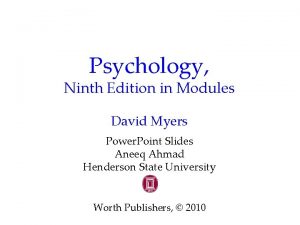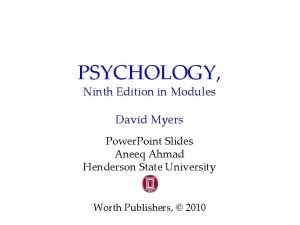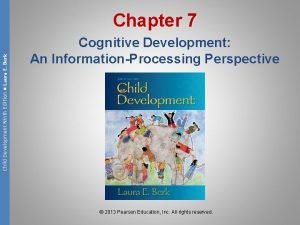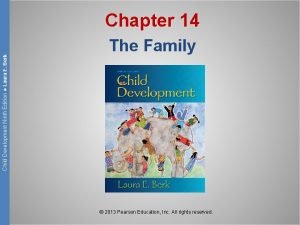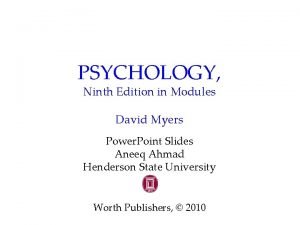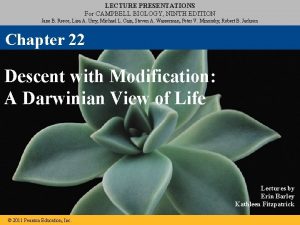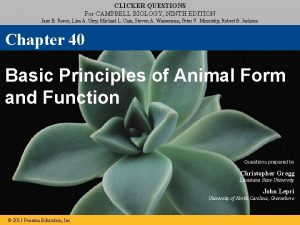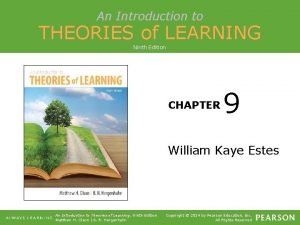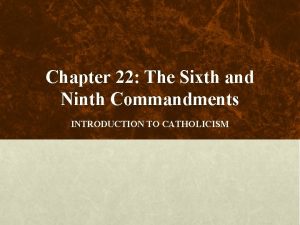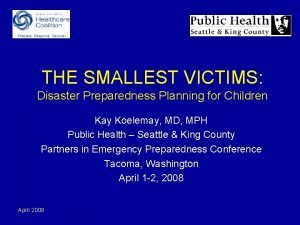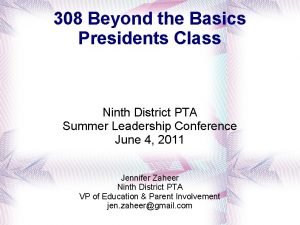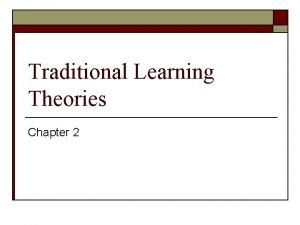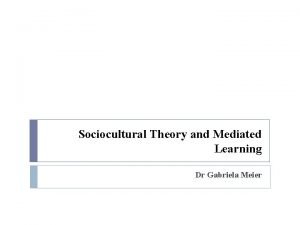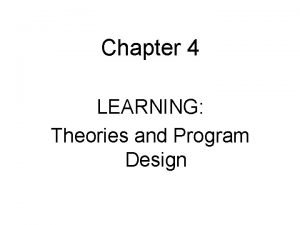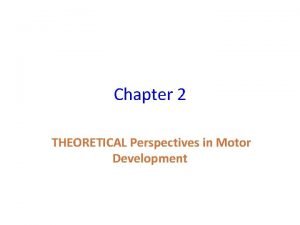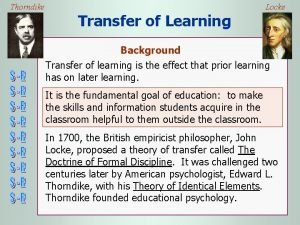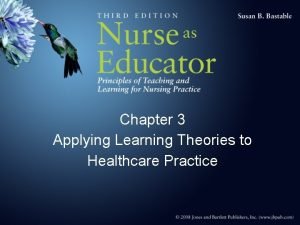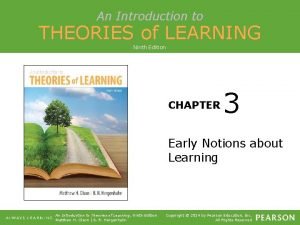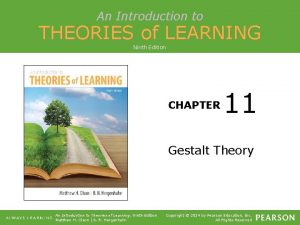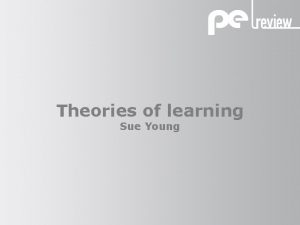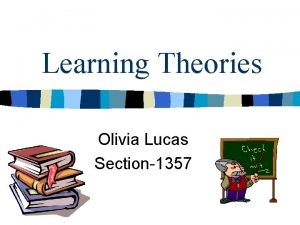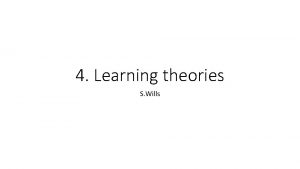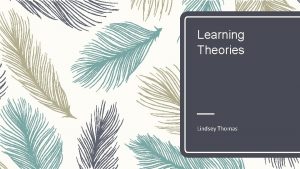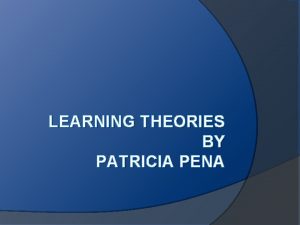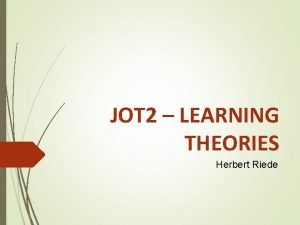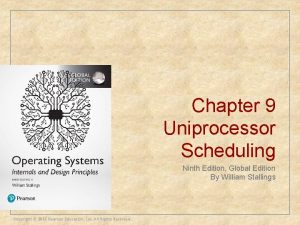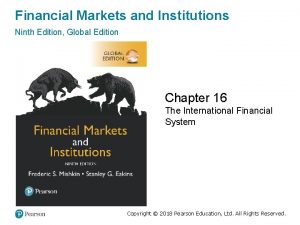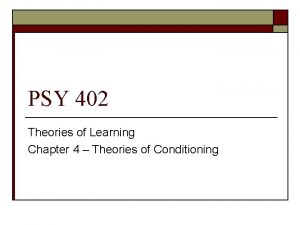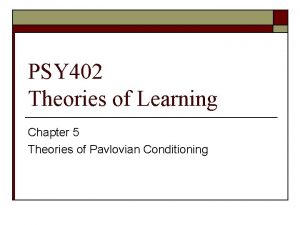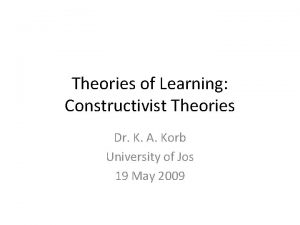An Introduction to THEORIES of LEARNING Ninth Edition
































- Slides: 32

An Introduction to THEORIES of LEARNING Ninth Edition CHAPTER 9 William Kaye Estes An Introduction to Theories of Learning, Ninth Edition Matthew H. Olson | B. R. Hergenhahn Copyright © 2014 by Pearson Education, Inc. All Rights Reserved

William Kaye Estes (1919— 2011) An Introduction to Theories of Learning, Ninth Edition Matthew H. Olson | B. R. Hergenhahn Copyright © 2014 by Pearson Education, Inc. All Rights Reserved

Stimulus Sampling Theory (SST) • Statistical learning theory differs from other theories. • An attempt to describe the “composition” of learning, but it does not provide tools for the classroom or for behavior therapy. An Introduction to Theories of Learning, Ninth Edition Matthew H. Olson | B. R. Hergenhahn Copyright © 2014 by Pearson Education, Inc. All Rights Reserved

Major Theoretical Concepts • The learning situation involves a large but finite number of stimulus elements called S. • Includes experimental events, such as a light, a lever… • Also includes changeable or transitory stimuli, such as extraneous noises inside the room, and the condition of the experimental participant. An Introduction to Theories of Learning, Ninth Edition Matthew H. Olson | B. R. Hergenhahn Copyright © 2014 by Pearson Education, Inc. All Rights Reserved

Major Theoretical Concepts • All responses are in one of two categories. • Correct responses are labeled A 1 • Incorrect responses are labeled A 2 An Introduction to Theories of Learning, Ninth Edition Matthew H. Olson | B. R. Hergenhahn Copyright © 2014 by Pearson Education, Inc. All Rights Reserved

Major Theoretical Concepts • Elements in the environment (S) are attached either to correct responses (A 1) or to incorrect responses (A 2) An Introduction to Theories of Learning, Ninth Edition Matthew H. Olson | B. R. Hergenhahn Copyright © 2014 by Pearson Education, Inc. All Rights Reserved

Major Theoretical Concepts • The learner experiences or samples only a small proportion of the stimuli available on any learning trial. • The size of the sample is constant throughout the experiment. An Introduction to Theories of Learning, Ninth Edition Matthew H. Olson | B. R. Hergenhahn Copyright © 2014 by Pearson Education, Inc. All Rights Reserved

Major Theoretical Concepts • The constant proportion of S experienced at the beginning of each learning trial is designated by Θ (theta). • After each trial, the elements in Θ are returned to S. An Introduction to Theories of Learning, Ninth Edition Matthew H. Olson | B. R. Hergenhahn Copyright © 2014 by Pearson Education, Inc. All Rights Reserved

Major Theoretical Concepts • A learning trial ends when a response occurs. • If an A 1 response terminates a trial, the stimulus elements in Θ are conditioned to the A 1 response. An Introduction to Theories of Learning, Ninth Edition Matthew H. Olson | B. R. Hergenhahn Copyright © 2014 by Pearson Education, Inc. All Rights Reserved

Major Theoretical Concepts • Elements in Θ are returned to S at the conclusion of a trial. • Because Θ sampled at the beginning of a learning trial is essentially random, the proportion of elements conditioned to A 1 in S will be reflected in the elements in Θ at the beginning of every new trial. An Introduction to Theories of Learning, Ninth Edition Matthew H. Olson | B. R. Hergenhahn Copyright © 2014 by Pearson Education, Inc. All Rights Reserved

MAJOR THEORETICAL CONCEPTS An Introduction to Theories of Learning, Ninth Edition Matthew H. Olson | B. R. Hergenhahn Copyright © 2014 by Pearson Education, Inc. All Rights Reserved

Major Theoretical Concepts • The probability of response A 1 on any trial n (Pn) is equal to the proportion of elements conditioned to A 1 on that trial (pn). • Pn =pn An Introduction to Theories of Learning, Ninth Edition Matthew H. Olson | B. R. Hergenhahn Copyright © 2014 by Pearson Education, Inc. All Rights Reserved

Major Theoretical Concepts • All elements are either A 1 elements (with probability p) or A 2 elements (with probability q). And these constitute 100 percent of the elements in the situation. • p + q = 1. 00 and p = 1. 00 – q An Introduction to Theories of Learning, Ninth Edition Matthew H. Olson | B. R. Hergenhahn Copyright © 2014 by Pearson Education, Inc. All Rights Reserved

Major Theoretical Concepts • The A 2 elements (with probability q) must be elements that were not preconditioned to A 1 prior to the first trial and that were not conditioned to A 1 on any previous trial. • Therefore q = (1 - P 1) (1 - Θ)n-1 An Introduction to Theories of Learning, Ninth Edition Matthew H. Olson | B. R. Hergenhahn Copyright © 2014 by Pearson Education, Inc. All Rights Reserved

Major Theoretical Concepts • Substituting for q in p = 1 – q, for the nth trial, we get the SST equation: • pn = 1 - (1 - P 1) (1 - Θ)n-1 • This is the essence of Stimulus Sampling Theory. An Introduction to Theories of Learning, Ninth Edition Matthew H. Olson | B. R. Hergenhahn Copyright © 2014 by Pearson Education, Inc. All Rights Reserved

SST Equation Produces • The negatively accelerated learning curve An Introduction to Theories of Learning, Ninth Edition Matthew H. Olson | B. R. Hergenhahn Copyright © 2014 by Pearson Education, Inc. All Rights Reserved

SST equation produces the negatively accelerated learning curve. An Introduction to Theories of Learning, Ninth Edition Matthew H. Olson | B. R. Hergenhahn Copyright © 2014 by Pearson Education, Inc. All Rights Reserved

Probability Matching • For example, left light comes on 75% of the time while right light comes on 25% of the time. • Experimental participant has to guess which light will come next. • Participant guesses 75% left/25% right. An Introduction to Theories of Learning, Ninth Edition Matthew H. Olson | B. R. Hergenhahn Copyright © 2014 by Pearson Education, Inc. All Rights Reserved

Probability Matching • Note that matching is irrational. If participant wanted to do well, guess left 100% of the time. • According to SST, matching occurs because § Pn= π - (π - P 1) (1 - Θ)n-1 • Where π = probability of the event– for example 75% left. An Introduction to Theories of Learning, Ninth Edition Matthew H. Olson | B. R. Hergenhahn Copyright © 2014 by Pearson Education, Inc. All Rights Reserved

Estes' Markov Model of Learning • Markov process: Characterized by an abrupt, step-wise change in response probabilities rather than a relatively slow, gradual change from trial to trial. • Contradicts Thorndike and Hull An Introduction to Theories of Learning, Ninth Edition Matthew H. Olson | B. R. Hergenhahn Copyright © 2014 by Pearson Education, Inc. All Rights Reserved

Why a Negatively Accelerated Learning Curve? • After correct response, the person would be correct on 100 percent of the subsequent trials, but people attained the correct response at different times. • The negatively accelerated learning curve results from averaging. An Introduction to Theories of Learning, Ninth Edition Matthew H. Olson | B. R. Hergenhahn Copyright © 2014 by Pearson Education, Inc. All Rights Reserved

Why a Negatively Accelerated Learning Curve? An Introduction to Theories of Learning, Ninth Edition Matthew H. Olson | B. R. Hergenhahn Copyright © 2014 by Pearson Education, Inc. All Rights Reserved

The Results from Averaging An Introduction to Theories of Learning, Ninth Edition Matthew H. Olson | B. R. Hergenhahn Copyright © 2014 by Pearson Education, Inc. All Rights Reserved

The Cognitive Array Model— Classifying and Categorizing • Examining a creature, noting that it has feathers, that it flies, and that it lays eggs, and then calling it “bird. ” • Physicians gather data and diagnose a common cold, rather than pneumonia, An Introduction to Theories of Learning, Ninth Edition Matthew H. Olson | B. R. Hergenhahn Copyright © 2014 by Pearson Education, Inc. All Rights Reserved

Array Model versus SST • SST focuses on stimulus-response associations formed in the past and the way in which those associations were accumulated. • Array model focuses on the classification of events that are encountered in the present or that will be encountered in the future. An Introduction to Theories of Learning, Ninth Edition Matthew H. Olson | B. R. Hergenhahn Copyright © 2014 by Pearson Education, Inc. All Rights Reserved

SST Assumes Additive Stimulus Relationships An Introduction to Theories of Learning, Ninth Edition Matthew H. Olson | B. R. Hergenhahn Copyright © 2014 by Pearson Education, Inc. All Rights Reserved

The Array Model Assumes Multiplicative Stimulus Relationships • A factor called s, the similarity coefficient, describes the degree of similarity between pairs of stimulus attributes. • Apply a similarity coefficient of unity (1. 00) if the features match and a coefficient with some smaller value s, if they differ. An Introduction to Theories of Learning, Ninth Edition Matthew H. Olson | B. R. Hergenhahn Copyright © 2014 by Pearson Education, Inc. All Rights Reserved

Items within a Category Are Similar to Each Other An Introduction to Theories of Learning, Ninth Edition Matthew H. Olson | B. R. Hergenhahn Copyright © 2014 by Pearson Education, Inc. All Rights Reserved

Stimulus Items Represent a Whole Category: A items with Category A An Introduction to Theories of Learning, Ninth Edition Matthew H. Olson | B. R. Hergenhahn Copyright © 2014 by Pearson Education, Inc. All Rights Reserved

Stimulus Items Represent a Whole Category: A items with Category B An Introduction to Theories of Learning, Ninth Edition Matthew H. Olson | B. R. Hergenhahn Copyright © 2014 by Pearson Education, Inc. All Rights Reserved

How Do We Recognize 2 A as Part of the A Category? • The probability of correctly recognizing stimulus 2 A as a member of A is (1+s) _____ (1+s) +(s 2 +s 3) An Introduction to Theories of Learning, Ninth Edition Matthew H. Olson | B. R. Hergenhahn Copyright © 2014 by Pearson Education, Inc. All Rights Reserved

Estes on Reinforcement • Following Guthrie, Estes believed that reinforcement prevented the unlearning of an association. • Estes’s more recent view of the role of reinforcement stressed the information that it provided to the organism. An Introduction to Theories of Learning, Ninth Edition Matthew H. Olson | B. R. Hergenhahn Copyright © 2014 by Pearson Education, Inc. All Rights Reserved
 Psychology ninth edition in modules
Psychology ninth edition in modules Macroeconomics ninth edition
Macroeconomics ninth edition Human anatomy & physiology edition 9
Human anatomy & physiology edition 9 General adaptation syndrome
General adaptation syndrome Social psychology ninth edition
Social psychology ninth edition Biology ninth edition
Biology ninth edition Laura e berk child development (9th edition pdf)
Laura e berk child development (9th edition pdf) Child development ninth edition
Child development ninth edition Lysanx
Lysanx Psychology ninth edition in modules
Psychology ninth edition in modules David myers psychology 9th edition
David myers psychology 9th edition Biology ninth edition
Biology ninth edition Campbell ninth edition
Campbell ninth edition An introduction to theories of learning
An introduction to theories of learning The 6th commandment catholic
The 6th commandment catholic The sixth and ninth commandments
The sixth and ninth commandments Photo/phos root word
Photo/phos root word Ramadan ninth month
Ramadan ninth month William blount ninth grade academy
William blount ninth grade academy Lower ninth ward
Lower ninth ward 17 classical menu with example
17 classical menu with example Ninth district pta
Ninth district pta Using mis (10th edition) 10th edition
Using mis (10th edition) 10th edition Report
Report Cuadro comparativo e-learning y b-learning
Cuadro comparativo e-learning y b-learning Traditional learning theories
Traditional learning theories Sociocultural theories of learning
Sociocultural theories of learning Learning theories and program design
Learning theories and program design Motor learning theories
Motor learning theories Humanistic theories examples
Humanistic theories examples Theory of learning
Theory of learning Applying learning theories to healthcare practice
Applying learning theories to healthcare practice Psychological factors influencing learning
Psychological factors influencing learning
